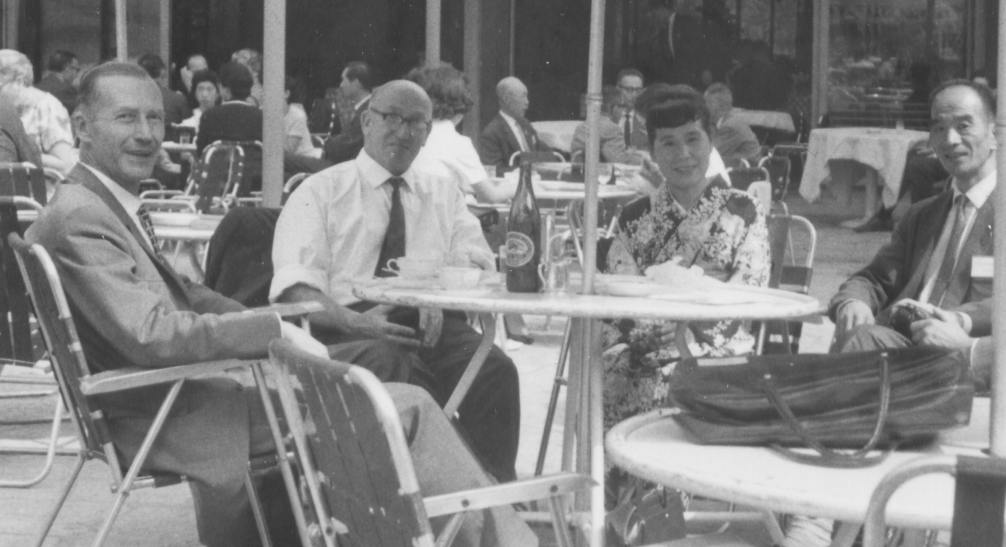- Louis Essen
Infobox Scientist
name = Louis Essen
box_width =
image_width =150px
caption = Louis Essen (left center) with Udo Adelsberger (extreme left)
birth_date =September 6 ,1908
birth_place =Nottingham
death_date =August 24 ,1997
death_place =Great Bookham ,Surrey
residence =
citizenship =
nationality = English
ethnicity =
field =physics
work_institutions =
alma_mater =
doctoral_advisor =D. W. Dye
doctoral_students =
known_for =speed of light
author_abbrev_bot =
author_abbrev_zoo =
influences =
influenced =
prizes =
religion =
footnotes =Louis Essen (
September 6 ,1908 –August 24 ,1997 ) was an Englishphysicist whose most notable achievements were in the precise measurement oftime and the determination of thespeed of light . He was critical ofAlbert Einstein 'stheory of relativity , particularly as it related totime dilation .Early work
Born in
Nottingham , Essen earned his degree inphysics from theUniversity of London in 1928, having studied at University College Nottingham. He started work at the National Physical Laboratory (NPL) the following year, underD. W. Dye , investigating the potential oftuning fork s andquartz crystal oscillator s for precise time measurement. His research led to his development of thequartz ring clock in 1938, the clock soon becoming a standard for time measurement at observatories throughout the world.The speed of light
During
World War II , Essen worked onradar and developed a number of instruments, including thecavity resonance wavemeter . It was this work that suggested to Essen the possibility of a more precise measurement of the speed of light. In 1946, in collaboration withA.C. Gordon-Smith , he used a microwave cavity, of precisely known dimensions, and exploited his expertise in time-measurement to establish thefrequency for a variety of itsnormal mode s. As thewavelength of the modes was known from the geometry of the cavity and fromelectromagnetic theory , knowledge of the associated frequencies enabled a calculation of the speed of light. Their result, 299,792±3 km/s, was substantially greater than the prevailing sequence of optical measurements that had begun around the start of the 20th century and Essen had to withstand some fierce criticism and disbelief. Even NPL director SirCharles Galton Darwin , while supporting the work, observed that Essen would get the "correct result" once he had perfected the technique. Moreover,W.W. Hansen atStanford University had used a similar technique and obtained a measurement which was more consistent with the conventional (optical) wisdom. However, a combination of Essen's stubbornness, his iconoclasm and his belief in his own skill at measurement (and a little help with calculations fromAlan Turing ) inspired him to refine his apparatus and to repeat his measurement in 1950, establishing a result of 299,792.5±1 km/s, . This was the value adopted by the 12th General Assembly of theRadio-Scientific Union in 1957. Most subsequent measurements have been consistent with this value. In 1983, the 17thConférence Générale des Poids et Mesures adopted the standard value, 299,792.458 km/s for the speed of light.Atomic clocks
Essen earned his Ph.D. (1941) and D.Sc. (1948) from the University of London before becoming interested in the possibility of using the frequency of atomic spectra to improve time measurement. The feasibility of measuring time using
caesium as an atomic reference had been demonstrated by the USNational Bureau of Standards . In 1955, he developed, [Essen, L., and Perry, J. V. (1955), "An atomic standard of frequency and time keeping", Nature 176, p. 280.] in collaboration with Jack Parry, the first practicalatomic clock by integrating the caesium atomic standard with conventional quartz crystal oscillators to allow calibration of existing time-keeping.Time standards
This work led Essen to champion the caesium spectrum as an international time standard. The
ammonia molecule had already been proposed as such but Essen was convinced that caesium would prove more stable. However, theInternational Astronomical Union meeting inDublin in 1955 had adopted theephemeris time , developed bySimon Newcomb in the 19th century in terms of the Earth’s motion round the sun. The ephemeris second became a standard in 1960 but in 1967, at the 13th Conférence Générale des Poids et Mesures, thesecond was redefined in terms of the spectrum of caesium that had been precisely measured by Essen in collaborationWilliam Markowitz of theUnited States Naval Observatory .Later life
Essen spent all his working life at the National Physical Laboratory.
In 1971 he published "The Special Theory of Relativity: A Critical Analysis" [Essen, L. (1971) The Special Theory of Relativity: A Critical Analysis, Oxford University Press (Oxford science research papers, 5). , booklet in which he questioned the modern interpretation of the special theory of relativity.] in which he questioned Einstein's theory, which apparently was not appreciated by his employers.As Essen later stated (1978) [Essen, L. (1978) "Relativity and Time Signals", Electronics and Wireless World, Oct. 1978, p. 14; compare also: Essen, L. (1988) "Relativity - Joke or Swindle?", "Electronics and Wireless World" 94, 126 - 127.] :
"No one has attempted to refute my arguments, but I was warned that if I persisted I was likely to spoil my career prospects."
He retired in 1972 and died in
Great Bookham ,Surrey .Honours
*
A.S. Popov Gold Medal from theUSSR Academy of Sciences - (1959)
*O.B.E. - (1959)
*Fellow of theRoyal Society - (1960)
*Rabi Award of theIEEE - (1987)References
External links
* [http://www.btinternet.com/~time.lord/ "Time Lord" Louis Essen]
* [http://www.sciencemuseum.org.uk/on-line/atomclocks/page1.asp Sciencemuseum: Louis Essen and atomic clocks]
Wikimedia Foundation. 2010.
